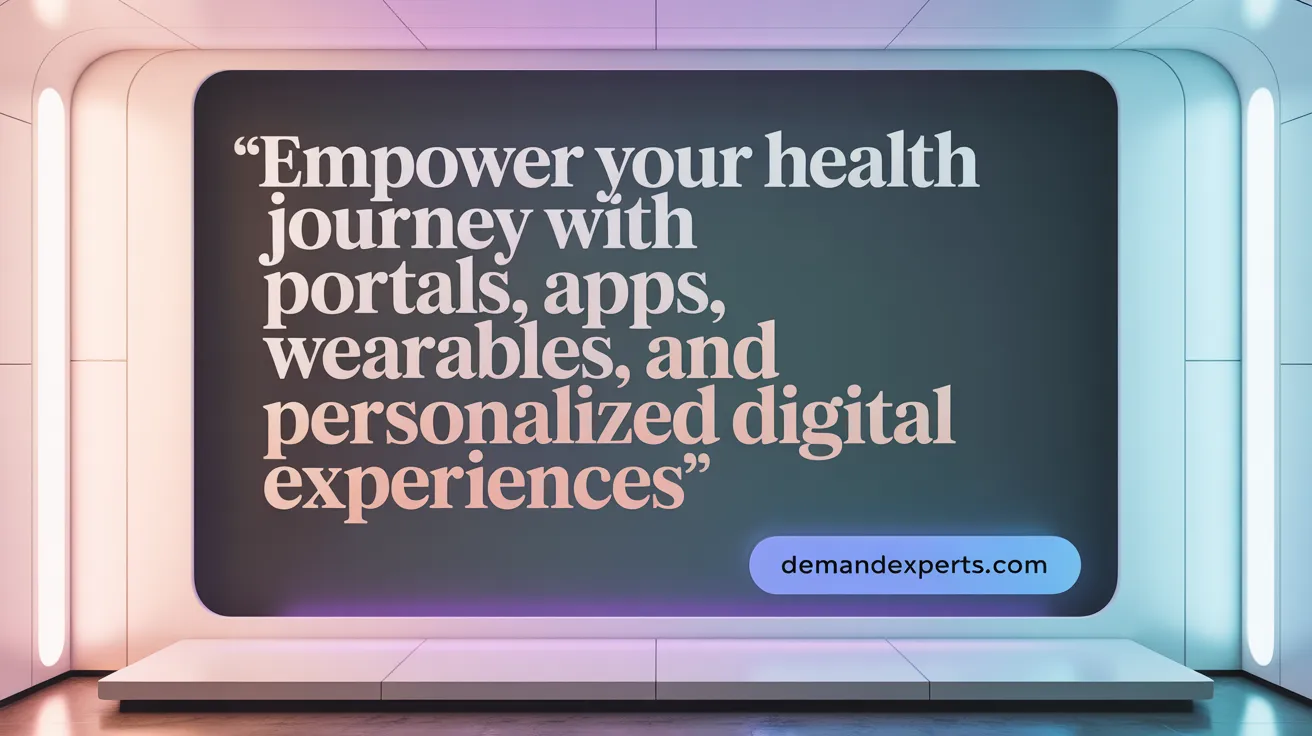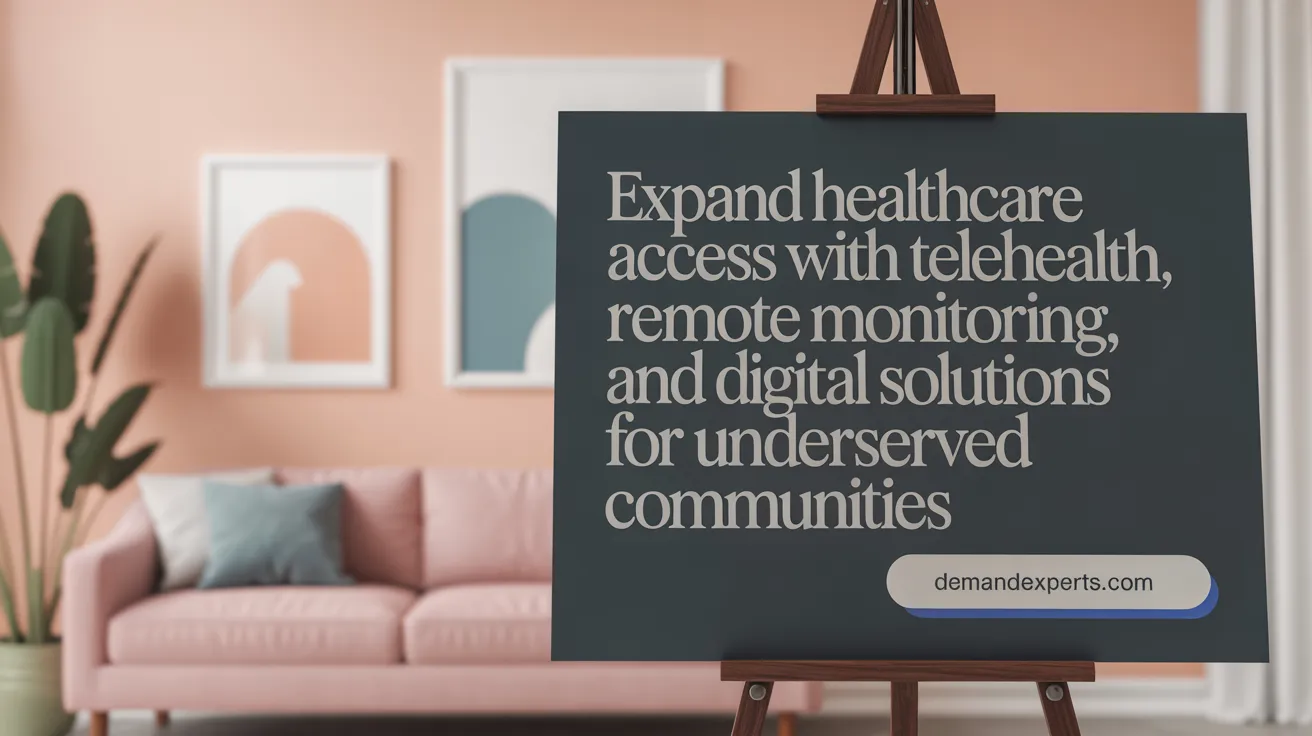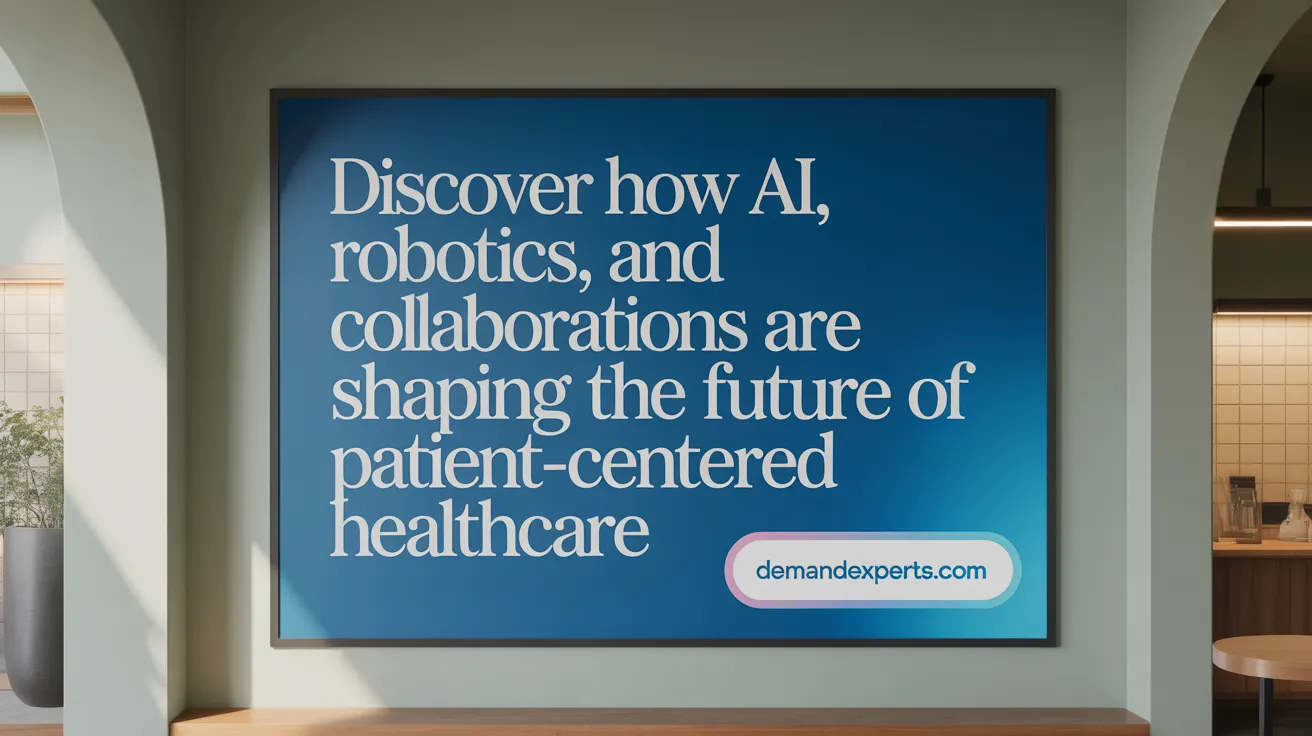The Shift to Digital Patient-Centricity in Healthcare
Importance of patient-centric digital experiences
Patient-centric digital experiences place patients at the heart of healthcare interactions, enabling personalized, seamless, and empathetic engagement. These experiences prioritize intuitive design, simplified navigation, and connectivity across devices, ensuring that patients receive tangible benefits such as trust, support, and tailored information. Tools like the Digital Experience Scale for Patients (DES/P) have been developed to assess and improve these patient-focused experiences, reflecting their critical role in health outcomes and satisfaction.
Overview of digital transformation in healthcare
Healthcare is undergoing a profound digital transformation driven by the integration of electronic health records (EHRs), telemedicine, AI-powered diagnostics, wearable devices, and advanced analytics. This shift involves adopting interoperable systems that enable real-time data exchange among providers and patients, improving care coordination and operational efficiency. Telehealth services and mobile apps extend care beyond traditional settings, facilitating remote monitoring and patient empowerment. Regulatory frameworks and partnerships across technology companies further support this evolution toward more secure, accessible, and personalized digital ecosystems.
Impact on patient care quality and accessibility
Digitally enabled patient-centric care enhances quality by providing timely, precise information and facilitating shared decision-making. The convenience of telehealth and online portals improves access, especially for rural or underserved populations, reducing barriers such as travel and scheduling constraints. AI and wearable technologies support continuous health monitoring and early intervention, improving treatment adherence and outcomes. Overall, digital transformation fosters equitable healthcare by bridging gaps, streamlining workflows, and empowering patients with greater control over their health journey.
Defining Patient-Centric Digital Health Experiences
What characterizes patient-centric digital health?
Patient-centric digital health emphasizes personalized, accessible, and collaborative care experiences that place patients at the core of their healthcare journey. It integrates digital tools and platforms to empower patients, improve communication, and foster trust between patients and providers. These solutions prioritize delivering tangible health benefits while ensuring ease of use and fostering ongoing engagement.
How does the Digital Experience Scale for Patients (DES/P) framework support this?
Developed through extensive research involving diverse patient populations, the DES/P framework evaluates digital health tools across twelve criteria within three critical categories: value, simplicity, and connectivity. Unlike generic usability measures, DES/P is specifically designed to capture the nuances of patient digital experiences in healthcare, providing robust and actionable insights to enhance these tools.
What are the patient needs captured in value, simplicity, and connectivity?
- Value: Patients seek digital health solutions that offer genuine benefits, empathetic support, personalized interactions, and trustworthy content (see Empathy and Personalization in Health Tech).
- Simplicity: Intuitive navigation, easy-to-understand language, and guided processes are essential to reduce frustration and improve adoption (refer to Importance of Simplicity in Digital Health Tools.
- Connectivity: Seamless integration across devices, social proof, community engagement, and reliable platform security enhance the overall patient experience (explore Connectivity in Patient Digital Experiences.
By focusing on these dimensions, healthcare organizations can create digital health environments that truly resonate with patient expectations and promote better care outcomes.
Harnessing Technology to Enhance Engagement and Empowerment

Use of portals, apps, telehealth, and wearable devices
Digital health technologies have revolutionized how patients engage with their healthcare. Patient portals provide a secure platform for viewing medical records, scheduling appointments, and communicating with providers, fostering greater autonomy and active participation in care. Mobile health apps and telehealth expand access by enabling remote consultations and real-time monitoring, especially beneficial for chronic disease management and underserved populations. Wearable devices capture continuous health data, empowering patients through self-monitoring and personalized feedback that supports more proactive health management.
Role of AI and machine learning in personalized care
Artificial intelligence (AI) and machine learning enhance patient engagement by delivering tailored healthcare experiences. These technologies power predictive analytics that foresee patient needs, automate appointment scheduling, and personalize reminders, improving adherence and convenience. AI-driven diagnostic tools and digital pathology platforms accelerate accurate assessments, guiding individualized treatments. Through integration of vast datasets—including genomics and patient-reported outcomes—AI supports clinicians in making informed decisions while providing patients with more precise, responsive care.
Digital storytelling and narrative medicine for patient voice
Digital storytelling and narrative medicine platforms capture patients' lived experiences, enriching clinical understanding and improving outcomes. These tools enable patients to share illness narratives and feedback through digital diaries and narrative platforms, promoting empowerment and a sense of agency. Integrating these narratives into care enhances communication, builds therapeutic relationships, and uncovers insights traditional methods may miss, ultimately elevating patient-centered care.
Collectively, these technologies cultivate a patient-centric healthcare environment that enhances engagement, supports self-management, and drives better health outcomes through personalized and collaborative digital experiences. The use of frameworks like the Digital Experience Scale for Patients (DES/P) framework helps guide improvements by measuring patient digital experiences systematically, ensuring that digital tools meet patient needs effectively. Additionally, standards like Fast Healthcare Interoperability Resources (FHIR) and the CMS Interoperability Framework facilitate secure and seamless data sharing across platforms, enabling a unified and comprehensive digital health ecosystem.
Streamlining Patient Journeys with Seamless Digital Integration

What is the Digital Front Door and Why Is It Important?
The digital front door is a comprehensive approach to patient engagement that goes beyond traditional websites by providing a unified online platform for healthcare interactions. It serves as an accessible entry point for patients to manage appointments, access health records, communicate with providers, and receive personalized care recommendations. This concept aligns healthcare digital experiences with those seen in retail and fintech, emphasizing convenience, brand consistency, and trust throughout every touchpoint (Digital Front Door for Patient Engagement, digital patient experience).
How Does Interoperability Influence Patient Experience?
Interoperability remains a major challenge in healthcare technology integrations, often causing fragmented user experiences and inconsistent data availability. The Fast Healthcare Interoperability Resources (FHIR) standard is pivotal in addressing this by enabling standardized data exchange across disparate healthcare systems. This allows patient information—from EHRs to wearable devices—to flow seamlessly, supporting care coordination and real-time clinical decision-making. Successful interoperability leads to more personalized, efficient, and connected digital patient journeys (CMS Interoperability Framework, healthcare interoperability and EHRs, FHIR healthcare data standard.
What Role Do Automated Workflows and Digital Scheduling Play?
Automation improves operational efficiency and enhances patient satisfaction by streamlining administrative tasks. Features such as online appointment scheduling, automated reminders, pre-visit digital check-ins, and referral management reduce wait times and administrative burdens. Digital communication channels—including secure messaging and centralized notifications—facilitate timely patient-provider interactions. By integrating these workflows into a single, user-friendly platform, healthcare organizations can increase engagement, reduce friction, and support patients from initial contact to post-care follow-up (Simplifying digital administrative tasks, online appointment scheduling, digital patient engagement).
Improving Access and Equity Through Telehealth and Remote Monitoring

Telehealth Expansion and Benefits
Telehealth has rapidly expanded as a vital healthcare delivery method, significantly increasing access to care, especially for follow-up appointments, chronic disease management, and behavioral health services. It enables patients to consult healthcare providers remotely using video or phone, reducing travel burdens and exposure risks. Approximately 76% of care providers now utilize virtual visits, reflecting telehealth's role in enhancing convenience and supporting continuous care (Telehealth technology).
Remote Patient Monitoring via Wearables and IoT
Wearable medical devices and Internet of Things (IoT) technologies facilitate real-time health tracking and remote monitoring. These tools empower patients to self-manage conditions by providing data on vital signs such as heart rate, blood pressure, and glucose levels. Integration of connected devices supports seamless healthcare workflows, enabling healthcare teams to intervene proactively and personalize treatment plans (Improving patient care through digital health technologies).
Bridging Gaps for Underserved and Rural Populations
Telehealth and remote monitoring address access disparities among underserved and rural populations. Digital solutions overcome geographic and transportation barriers by delivering specialist care and chronic disease management remotely. Technologies like medical drones and virtual medical translators further support equitable care delivery. This digital expansion promotes health equity by extending quality healthcare beyond traditional clinical settings, reducing disparities, and enabling continuous patient engagement across diverse communities (Addressing health equity with technology.
Data-Driven Personalization and Analytics to Elevate Patient Care
Leveraging EHRs, CRM, and AI for personalization
Electronic Health Records (EHRs) and Customer Relationship Management (CRM) systems serve as foundational tools enabling healthcare providers to deliver personalized patient experiences. By integrating clinical data, prescription histories, and demographic details, these systems empower tailored communication and interventions. Artificial Intelligence (AI) enhances personalization by providing decision support, automating routine workflows, and delivering predictive alerts that anticipate patient needs, culminating in improved care precision and engagement. For more on Patient-centric digital healthcare and the role of AI in healthcare, see these resources.
Use of Patient-Reported Outcome Measures (PROMs)
Patient-reported outcome measures are crucial for capturing the patient's voice regarding symptoms, functionality, and satisfaction. Integrating PROMs into digital platforms facilitates real-time collection and analysis, reducing administrative burden and allowing clinicians to monitor health trajectories comprehensively. Incorporating PROMs supports value-based healthcare objectives by ensuring treatment aligns with patient-centered outcomes and enhances shared decision-making. Learn more about Digital health innovations and the use of PROMs automation with digital platforms.
Predictive models and digital health marketing strategies
Advanced predictive modeling harnesses de-identified claims and population health data to forecast individual health behaviors such as adherence or treatment-seeking patterns. These insights enable highly targeted marketing campaigns through digital channels optimized via SEO, social media, and paid advertising, enhancing patient acquisition and engagement. Considering social determinants of health (SDOH) within these models further refines outreach, addressing barriers and promoting equitable care access. For strategies on healthcare digital marketing and winning strategies for digital patient acquisition, see these references.
Together, data-driven personalization complemented by analytic capabilities presents a transformative pathway toward patient-centric care, optimizing both clinical outcomes and patient engagement through informed, tailored strategies. Additional insights on leveraging EHRs and AI for personalization and improving patient engagement with technology can be found in these materials.
Building Trust and Compliance in Digital Healthcare Experiences

Privacy, data security, and HIPAA compliance
Ensuring patient privacy and robust data security is fundamental in digital healthcare. Compliance with regulations such as HIPAA Compliance in Marketing safeguards sensitive health information, fostering patient trust. Healthcare organizations implement secure protocols to protect digital interactions, from portals to telehealth platforms, minimizing risks of breaches while enabling seamless care delivery, aligned with Healthcare Digitization Benefits.
Digital identity solutions and secure data exchange
Modern digital identity solutions streamline secure patient authentication and health data sharing. Initiatives like the CMS Interoperability Framework and digital identity integration for Medicare.gov exemplify efforts to enable patients and providers to exchange health records securely. These technological advances support privacy-preserving access, simplify user experience, and ensure controlled data interoperability across platforms, as explained in the context of Fast Healthcare Interoperability Resources (FHIR) and CMS Interoperability Framework.
Transparent communication and reputation management
Transparent communication reinforces trust in digital healthcare environments. Sharing clear privacy policies, obtaining patient consent, and maintaining open dialogue about data use bolster credibility. In addition, proactive reputation management through monitoring feedback and encouraging positive experiences enhances patient confidence and loyalty, contributing to a patient-centered digital ecosystem as discussed in Healthcare Marketing Best Practices and Patient Engagement in Healthcare Marketing.
Future Directions: Innovations and Collaborative Ecosystems for Better Care

Emerging AI applications and robotics in healthcare
Artificial intelligence (AI) is profoundly shaping the future of patient-centered healthcare by enhancing diagnostics, enabling personalized medicine, and streamlining clinical workflows. Leading institutions like Mayo Clinic employ AI-driven tools for precise identification of seizure hotspots in epilepsy patients and digital pathology platforms that improve diagnostic speed and accuracy (Artificial Intelligence Enhances Patient Experience). Robotics complements these advances by facilitating precision surgeries, medication dispensing, and rehabilitation, offering safer and more effective treatments. These technologies promise to reduce provider burden while elevating care quality and patient outcomes (Patient-Centric Digital Healthcare).
Collaborations among tech leaders and government initiatives
The future of healthcare digital transformation is underpinned by strategic partnerships involving tech giants such as Amazon, Apple, Google, and OpenAI, aligned with government frameworks like the CMS Interoperability Framework. These collaborations focus on seamless and secure health information exchange, personalized digital health tools, and scalable solutions such as national provider directories and modern digital identity systems (White House Tech Leaders Commit to Create Patient-Centric Healthcare Ecosystem). Over 60 companies have committed to these initiatives with goals mapped through 2026, supporting innovations including conversational AI for symptom checking and digital check-ins, thereby expanding patient access and engagement (White House Healthcare Initiative and Tech Leaders Collaboration.
Challenges and strategies for sustainable digital transformation
Despite promising innovations, challenges like integration complexity, data privacy, infrastructure costs, and digital literacy gaps remain significant. Addressing these requires a cohesive strategy combining robust cloud-native platforms, standardized data protocols such as Fast Healthcare Interoperability Resources (FHIR), single sign-on functionality, and stringent security measures (Digital Patient Experience and Healthcare Integration. Additionally, participatory design involving patients and clinicians ensures technology usability and inclusivity (Patients' Perspectives on Digital Health Tools). Continuous education, adaptive workflows, and iterative development anchored in patient feedback are essential to sustainably embed digital solutions into existing healthcare ecosystems, thereby advancing equity and improving overall health outcomes (Improving Patient-Centered Digital Platforms.
Empowering Patients Through Continued Digital Evolution
Enhanced Patient-Centric Digital Experiences
Patient-centric digital health experiences notably improve health outcomes by offering personalized, accessible, and seamless care. Benefits include greater patient empowerment, real-time health monitoring, increased treatment adherence, and improved communication with care teams. Technologies such as telehealth, wearable devices, AI-driven diagnostics, and integrated patient portals contribute to more informed, engaged, and satisfied patients.
Continuous Technological Advancements
The digital evolution in healthcare supports ongoing improvements in care delivery. AI enhances decision-making and predictive analytics, while interoperable platforms facilitate seamless data exchange. Telemedicine expands access, especially for underserved populations, and digital tools automate administrative workflows, freeing providers to focus on patient-centered care. Collectively, these innovations foster a holistic, efficient, and inclusive healthcare ecosystem.
Call to Action for Healthcare Providers
Healthcare organizations must strategically invest in digital patient experiences to stay competitive and patient-focused. Prioritizing digital accessibility, intuitive interfaces, personalized communication, and interoperability enables better engagement and health equity. Embracing this digital transformation is imperative to empower patients, optimize clinical workflows, and realize measurable growth in patient acquisition and retention.
The Shift to Digital Patient-Centricity in Healthcare
Importance of patient-centric digital experiences
Patient-centric digital experiences place patients at the heart of healthcare interactions, enabling personalized, seamless, and empathetic engagement. These experiences prioritize intuitive design, simplified navigation, and connectivity across devices, ensuring that patients receive tangible benefits such as trust, support, and tailored information. Tools like the Digital Experience Scale for Patients (DES/P) have been developed to assess and improve these patient-focused experiences, reflecting their critical role in health outcomes and satisfaction.
Overview of digital transformation in healthcare
Healthcare is undergoing a profound digital transformation driven by the integration of electronic health records (EHRs), telemedicine, AI-powered diagnostics, wearable devices, and advanced analytics. This shift involves adopting interoperable systems that enable real-time data exchange among providers and patients, improving care coordination and operational efficiency. Telehealth services and mobile apps extend care beyond traditional settings, facilitating remote monitoring and patient empowerment. Regulatory frameworks and partnerships across technology companies further support this evolution toward more secure, accessible, and personalized digital ecosystems.
Impact on patient care quality and accessibility
Digitally enabled patient-centric care enhances quality by providing timely, precise information and facilitating shared decision-making. The convenience of telehealth and online portals improves access, especially for rural or underserved populations, reducing barriers such as travel and scheduling constraints. AI and wearable technologies support continuous health monitoring and early intervention, improving treatment adherence and outcomes. Overall, digital transformation fosters equitable healthcare by bridging gaps, streamlining workflows, and empowering patients with greater control over their health journey.
Defining Patient-Centric Digital Health Experiences
What characterizes patient-centric digital health?
Patient-centric digital health emphasizes personalized, accessible, and collaborative care experiences that place patients at the core of their healthcare journey. It integrates digital tools and platforms to empower patients, improve communication, and foster trust between patients and providers. These solutions prioritize delivering tangible health benefits while ensuring ease of use and fostering ongoing engagement.
How does the Digital Experience Scale for Patients (DES/P) framework support this?
Developed through extensive research involving diverse patient populations, the DES/P framework evaluates digital health tools across twelve criteria within three critical categories: value, simplicity, and connectivity. Unlike generic usability measures, DES/P is specifically designed to capture the nuances of patient digital experiences in healthcare, providing robust and actionable insights to enhance these tools.
What are the patient needs captured in value, simplicity, and connectivity?
- Value: Patients seek digital health solutions that offer genuine benefits, empathetic support, personalized interactions, and trustworthy content (see Empathy and Personalization in Health Tech).
- Simplicity: Intuitive navigation, easy-to-understand language, and guided processes are essential to reduce frustration and improve adoption (refer to Importance of Simplicity in Digital Health Tools.
- Connectivity: Seamless integration across devices, social proof, community engagement, and reliable platform security enhance the overall patient experience (explore Connectivity in Patient Digital Experiences.
By focusing on these dimensions, healthcare organizations can create digital health environments that truly resonate with patient expectations and promote better care outcomes.
Harnessing Technology to Enhance Engagement and Empowerment

Use of portals, apps, telehealth, and wearable devices
Digital health technologies have revolutionized how patients engage with their healthcare. Patient portals provide a secure platform for viewing medical records, scheduling appointments, and communicating with providers, fostering greater autonomy and active participation in care. Mobile health apps and telehealth expand access by enabling remote consultations and real-time monitoring, especially beneficial for chronic disease management and underserved populations. Wearable devices capture continuous health data, empowering patients through self-monitoring and personalized feedback that supports more proactive health management.
Role of AI and machine learning in personalized care
Artificial intelligence (AI) and machine learning enhance patient engagement by delivering tailored healthcare experiences. These technologies power predictive analytics that foresee patient needs, automate appointment scheduling, and personalize reminders, improving adherence and convenience. AI-driven diagnostic tools and digital pathology platforms accelerate accurate assessments, guiding individualized treatments. Through integration of vast datasets—including genomics and patient-reported outcomes—AI supports clinicians in making informed decisions while providing patients with more precise, responsive care.
Digital storytelling and narrative medicine for patient voice
Digital storytelling and narrative medicine platforms capture patients' lived experiences, enriching clinical understanding and improving outcomes. These tools enable patients to share illness narratives and feedback through digital diaries and narrative platforms, promoting empowerment and a sense of agency. Integrating these narratives into care enhances communication, builds therapeutic relationships, and uncovers insights traditional methods may miss, ultimately elevating patient-centered care.
Collectively, these technologies cultivate a patient-centric healthcare environment that enhances engagement, supports self-management, and drives better health outcomes through personalized and collaborative digital experiences. The use of frameworks like the Digital Experience Scale for Patients (DES/P) framework helps guide improvements by measuring patient digital experiences systematically, ensuring that digital tools meet patient needs effectively. Additionally, standards like Fast Healthcare Interoperability Resources (FHIR) and the CMS Interoperability Framework facilitate secure and seamless data sharing across platforms, enabling a unified and comprehensive digital health ecosystem.
Streamlining Patient Journeys with Seamless Digital Integration

What is the Digital Front Door and Why Is It Important?
The digital front door is a comprehensive approach to patient engagement that goes beyond traditional websites by providing a unified online platform for healthcare interactions. It serves as an accessible entry point for patients to manage appointments, access health records, communicate with providers, and receive personalized care recommendations. This concept aligns healthcare digital experiences with those seen in retail and fintech, emphasizing convenience, brand consistency, and trust throughout every touchpoint (Digital Front Door for Patient Engagement, digital patient experience).
How Does Interoperability Influence Patient Experience?
Interoperability remains a major challenge in healthcare technology integrations, often causing fragmented user experiences and inconsistent data availability. The Fast Healthcare Interoperability Resources (FHIR) standard is pivotal in addressing this by enabling standardized data exchange across disparate healthcare systems. This allows patient information—from EHRs to wearable devices—to flow seamlessly, supporting care coordination and real-time clinical decision-making. Successful interoperability leads to more personalized, efficient, and connected digital patient journeys (CMS Interoperability Framework, healthcare interoperability and EHRs, FHIR healthcare data standard.
What Role Do Automated Workflows and Digital Scheduling Play?
Automation improves operational efficiency and enhances patient satisfaction by streamlining administrative tasks. Features such as online appointment scheduling, automated reminders, pre-visit digital check-ins, and referral management reduce wait times and administrative burdens. Digital communication channels—including secure messaging and centralized notifications—facilitate timely patient-provider interactions. By integrating these workflows into a single, user-friendly platform, healthcare organizations can increase engagement, reduce friction, and support patients from initial contact to post-care follow-up (Simplifying digital administrative tasks, online appointment scheduling, digital patient engagement).
Improving Access and Equity Through Telehealth and Remote Monitoring

Telehealth Expansion and Benefits
Telehealth has rapidly expanded as a vital healthcare delivery method, significantly increasing access to care, especially for follow-up appointments, chronic disease management, and behavioral health services. It enables patients to consult healthcare providers remotely using video or phone, reducing travel burdens and exposure risks. Approximately 76% of care providers now utilize virtual visits, reflecting telehealth's role in enhancing convenience and supporting continuous care (Telehealth technology).
Remote Patient Monitoring via Wearables and IoT
Wearable medical devices and Internet of Things (IoT) technologies facilitate real-time health tracking and remote monitoring. These tools empower patients to self-manage conditions by providing data on vital signs such as heart rate, blood pressure, and glucose levels. Integration of connected devices supports seamless healthcare workflows, enabling healthcare teams to intervene proactively and personalize treatment plans (Improving patient care through digital health technologies).
Bridging Gaps for Underserved and Rural Populations
Telehealth and remote monitoring address access disparities among underserved and rural populations. Digital solutions overcome geographic and transportation barriers by delivering specialist care and chronic disease management remotely. Technologies like medical drones and virtual medical translators further support equitable care delivery. This digital expansion promotes health equity by extending quality healthcare beyond traditional clinical settings, reducing disparities, and enabling continuous patient engagement across diverse communities (Addressing health equity with technology.
Data-Driven Personalization and Analytics to Elevate Patient Care
Leveraging EHRs, CRM, and AI for personalization
Electronic Health Records (EHRs) and Customer Relationship Management (CRM) systems serve as foundational tools enabling healthcare providers to deliver personalized patient experiences. By integrating clinical data, prescription histories, and demographic details, these systems empower tailored communication and interventions. Artificial Intelligence (AI) enhances personalization by providing decision support, automating routine workflows, and delivering predictive alerts that anticipate patient needs, culminating in improved care precision and engagement. For more on Patient-centric digital healthcare and the role of AI in healthcare, see these resources.
Use of Patient-Reported Outcome Measures (PROMs)
Patient-reported outcome measures are crucial for capturing the patient's voice regarding symptoms, functionality, and satisfaction. Integrating PROMs into digital platforms facilitates real-time collection and analysis, reducing administrative burden and allowing clinicians to monitor health trajectories comprehensively. Incorporating PROMs supports value-based healthcare objectives by ensuring treatment aligns with patient-centered outcomes and enhances shared decision-making. Learn more about Digital health innovations and the use of PROMs automation with digital platforms.
Predictive models and digital health marketing strategies
Advanced predictive modeling harnesses de-identified claims and population health data to forecast individual health behaviors such as adherence or treatment-seeking patterns. These insights enable highly targeted marketing campaigns through digital channels optimized via SEO, social media, and paid advertising, enhancing patient acquisition and engagement. Considering social determinants of health (SDOH) within these models further refines outreach, addressing barriers and promoting equitable care access. For strategies on healthcare digital marketing and winning strategies for digital patient acquisition, see these references.
Together, data-driven personalization complemented by analytic capabilities presents a transformative pathway toward patient-centric care, optimizing both clinical outcomes and patient engagement through informed, tailored strategies. Additional insights on leveraging EHRs and AI for personalization and improving patient engagement with technology can be found in these materials.
Building Trust and Compliance in Digital Healthcare Experiences

Privacy, data security, and HIPAA compliance
Ensuring patient privacy and robust data security is fundamental in digital healthcare. Compliance with regulations such as HIPAA Compliance in Marketing safeguards sensitive health information, fostering patient trust. Healthcare organizations implement secure protocols to protect digital interactions, from portals to telehealth platforms, minimizing risks of breaches while enabling seamless care delivery, aligned with Healthcare Digitization Benefits.
Digital identity solutions and secure data exchange
Modern digital identity solutions streamline secure patient authentication and health data sharing. Initiatives like the CMS Interoperability Framework and digital identity integration for Medicare.gov exemplify efforts to enable patients and providers to exchange health records securely. These technological advances support privacy-preserving access, simplify user experience, and ensure controlled data interoperability across platforms, as explained in the context of Fast Healthcare Interoperability Resources (FHIR) and CMS Interoperability Framework.
Transparent communication and reputation management
Transparent communication reinforces trust in digital healthcare environments. Sharing clear privacy policies, obtaining patient consent, and maintaining open dialogue about data use bolster credibility. In addition, proactive reputation management through monitoring feedback and encouraging positive experiences enhances patient confidence and loyalty, contributing to a patient-centered digital ecosystem as discussed in Healthcare Marketing Best Practices and Patient Engagement in Healthcare Marketing.
Future Directions: Innovations and Collaborative Ecosystems for Better Care

Emerging AI applications and robotics in healthcare
Artificial intelligence (AI) is profoundly shaping the future of patient-centered healthcare by enhancing diagnostics, enabling personalized medicine, and streamlining clinical workflows. Leading institutions like Mayo Clinic employ AI-driven tools for precise identification of seizure hotspots in epilepsy patients and digital pathology platforms that improve diagnostic speed and accuracy (Artificial Intelligence Enhances Patient Experience). Robotics complements these advances by facilitating precision surgeries, medication dispensing, and rehabilitation, offering safer and more effective treatments. These technologies promise to reduce provider burden while elevating care quality and patient outcomes (Patient-Centric Digital Healthcare).
Collaborations among tech leaders and government initiatives
The future of healthcare digital transformation is underpinned by strategic partnerships involving tech giants such as Amazon, Apple, Google, and OpenAI, aligned with government frameworks like the CMS Interoperability Framework. These collaborations focus on seamless and secure health information exchange, personalized digital health tools, and scalable solutions such as national provider directories and modern digital identity systems (White House Tech Leaders Commit to Create Patient-Centric Healthcare Ecosystem). Over 60 companies have committed to these initiatives with goals mapped through 2026, supporting innovations including conversational AI for symptom checking and digital check-ins, thereby expanding patient access and engagement (White House Healthcare Initiative and Tech Leaders Collaboration.
Challenges and strategies for sustainable digital transformation
Despite promising innovations, challenges like integration complexity, data privacy, infrastructure costs, and digital literacy gaps remain significant. Addressing these requires a cohesive strategy combining robust cloud-native platforms, standardized data protocols such as Fast Healthcare Interoperability Resources (FHIR), single sign-on functionality, and stringent security measures (Digital Patient Experience and Healthcare Integration. Additionally, participatory design involving patients and clinicians ensures technology usability and inclusivity (Patients' Perspectives on Digital Health Tools). Continuous education, adaptive workflows, and iterative development anchored in patient feedback are essential to sustainably embed digital solutions into existing healthcare ecosystems, thereby advancing equity and improving overall health outcomes (Improving Patient-Centered Digital Platforms.
Empowering Patients Through Continued Digital Evolution
Enhanced Patient-Centric Digital Experiences
Patient-centric digital health experiences notably improve health outcomes by offering personalized, accessible, and seamless care. Benefits include greater patient empowerment, real-time health monitoring, increased treatment adherence, and improved communication with care teams. Technologies such as telehealth, wearable devices, AI-driven diagnostics, and integrated patient portals contribute to more informed, engaged, and satisfied patients.
Continuous Technological Advancements
The digital evolution in healthcare supports ongoing improvements in care delivery. AI enhances decision-making and predictive analytics, while interoperable platforms facilitate seamless data exchange. Telemedicine expands access, especially for underserved populations, and digital tools automate administrative workflows, freeing providers to focus on patient-centered care. Collectively, these innovations foster a holistic, efficient, and inclusive healthcare ecosystem.
Call to Action for Healthcare Providers
Healthcare organizations must strategically invest in digital patient experiences to stay competitive and patient-focused. Prioritizing digital accessibility, intuitive interfaces, personalized communication, and interoperability enables better engagement and health equity. Embracing this digital transformation is imperative to empower patients, optimize clinical workflows, and realize measurable growth in patient acquisition and retention.






